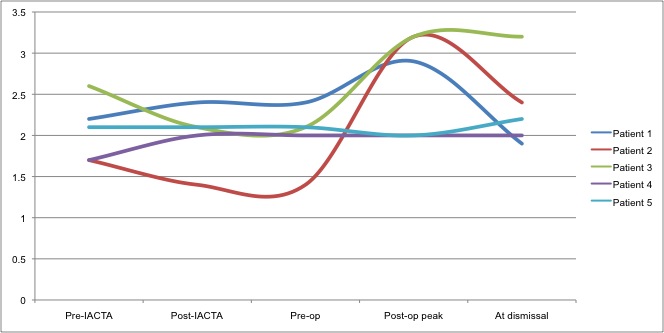|
Back to Annual Symposium Program
Low-dose intra-arterial contrast computed tomography angiography to plan endovascular repair of complex aneurysms in patients with severe renal dysfunction
Tiziano Tallarita, MD, Gustavo S. Oderich, MD, Thomas C. Bower, MD, Alexandre A. Pereira, MD, Jerome Breen, MD, Thanila A. Macedo, MD, James Andrews, MD.
Mayo Clinic, Rochester, MN, USA.
Purpose: This study evaluates the feasibility of a low dose intra-arterial contrast computed tomography angiography (IA-CTA) protocol to plan endovascular repair with fenestrated and branched endografts in patients with severe renal dysfunction and complex aortic aneurysms.
Methods: Five high-risk patients underwent IA-CTA prior to endovascular repair of 3 thoracoabdominal (TAAA) and 2 pararenal aortic aneurysms with fenestrated and branched endografts. All patients had stage IV chronic kidney disease with baseline serum creatinine (sCr) > 1.7 mg/dL and age > 70 years, which corresponded to an estimated glomerular filtration rate (eGFR) of < 30 mL/min/1.73m2. Three patients had diabetes. IA-CTA protocol required 5Fr transfemoral flush catheter positioned in the proximal descending thoracic aorta. IA-CTA was obtained using multi-slice helical scanner with total of 40 ml of non-ionic contrast agent diluted in 80 ml of normal saline and injected at 8 ml/sec for 15 seconds. End-points were feasibility of device design and procedure planning using IA-CTA images with centerline of flow measurements and changes in renal function.
Results: IA-CTA was obtained 7±6 days prior to endovascular repair. In two patients with contained ruptured TAAAs urgent repair was performed within <24 hours of IA-CTA (Figure 1). Imaging quality was excellent in all studies allowing procedure planning and device design. Endovascular repair was successfully performed using fenestrated and branched endografts in all patients, with no mortality. There were no changes in renal function parameters after IA-CTA, but three patients had rise in sCr after the endovascular repair, returning to baseline values within 3 months (Figure 2). After a median follow up of 6 months, all patients had stable renal function within baseline values.
Conclusion: Low-dose IA-CTA was successful in this pilot study, providing excellent imaging quality for device design in patients treated by fenestrated and branched endografts for complex aortic aneurysms. This technique may be useful to plan complex endovascular procedures in select patients with severe renal dysfunction.  
Back to Annual Symposium Program

|



